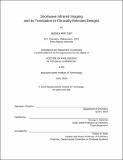Shortwave infrared imaging and its translation to clinically-relevant designs
Author(s)
Carr, Jessica Ann
DownloadFull printable version (8.050Mb)
Other Contributors
Massachusetts Institute of Technology. Department of Chemistry.
Advisor
Moungi G. Bawendi.
Terms of use
Metadata
Show full item recordAbstract
Visualizing structures deep within biological tissue is a central challenge in biomedical imaging, with both preclinical implications and clinical relevance. Using shortwave infrared (SWIR) light enables imaging with high resolution, high sensitivity, and sufficient penetration depth to noninvasively interrogate sub-surface tissue features. However, the clinical potential of this approach has been largely unexplored. Until recently, suitable detectors have been either unavailable or cost-prohibitive. Additionally, clinical adoption of SWIR imaging has been inhibited by a poor understanding of its advantages over conventional techniques. For fluorescence imaging in particular, there has further been a perceived need for clinically-approved contrast agents. Here, taking advantage of newly available detector technology, we investigate a variety of biomedical applications with SWIR-based imaging devices. We describe the development of a medical otoscope and our clinical observations using this device to evaluate middle ear pathologies in both adult and pediatric populations, showing that SWIR otoscopy could provide diagnostic information complementary to that provided by conventional visible otoscopy. We further describe fluorescence detection of an endogenous disease biomarker in animal models including nonalcoholic fatty liver disease and cirrhotic liver models and models of a neurodegenerative disease pathway. While this biomarker has been known for decades, we describe a method for its noninvasive detection in living animals using near infrared and SWIR light, as opposed to its conventional ex vivo detection. Furthermore, we show that SWIR image contrast and penetration depth are primarily mediated by the absorptivity of tissue, and can be tuned through deliberate selection of imaging wavelength. This understanding is crucial for rationally determining the optimal imaging window for a given application, and is a prerequisite for understanding which clinical applications could benefit from SWIR imaging. Finally, we show that commercially-available near infrared dyes, including the FDA-approved contrast agent indocyanine green, exhibit optical properties suitable for in vivo SWIR fluorescence imaging, including intravital microscopy, noninvasive, real-time imaging in blood and lymph vessels, and tumor-targeted imaging with IRDye 800CW, a dye being tested in clinical trials. Thus, we suggest that there is significant potential for SWIR imaging to be implemented alongside existing imaging modalities in the clinic.
Description
Thesis: Ph. D. in Physical Chemistry, Massachusetts Institute of Technology, Department of Chemistry, 2018. This electronic version was submitted by the student author. The certified thesis is available in the Institute Archives and Special Collections. Cataloged from student-submitted PDF version of thesis. Page 144 blank. Includes bibliographical references (pages 127-143).
Date issued
2018Department
Massachusetts Institute of Technology. Department of ChemistryPublisher
Massachusetts Institute of Technology
Keywords
Chemistry.